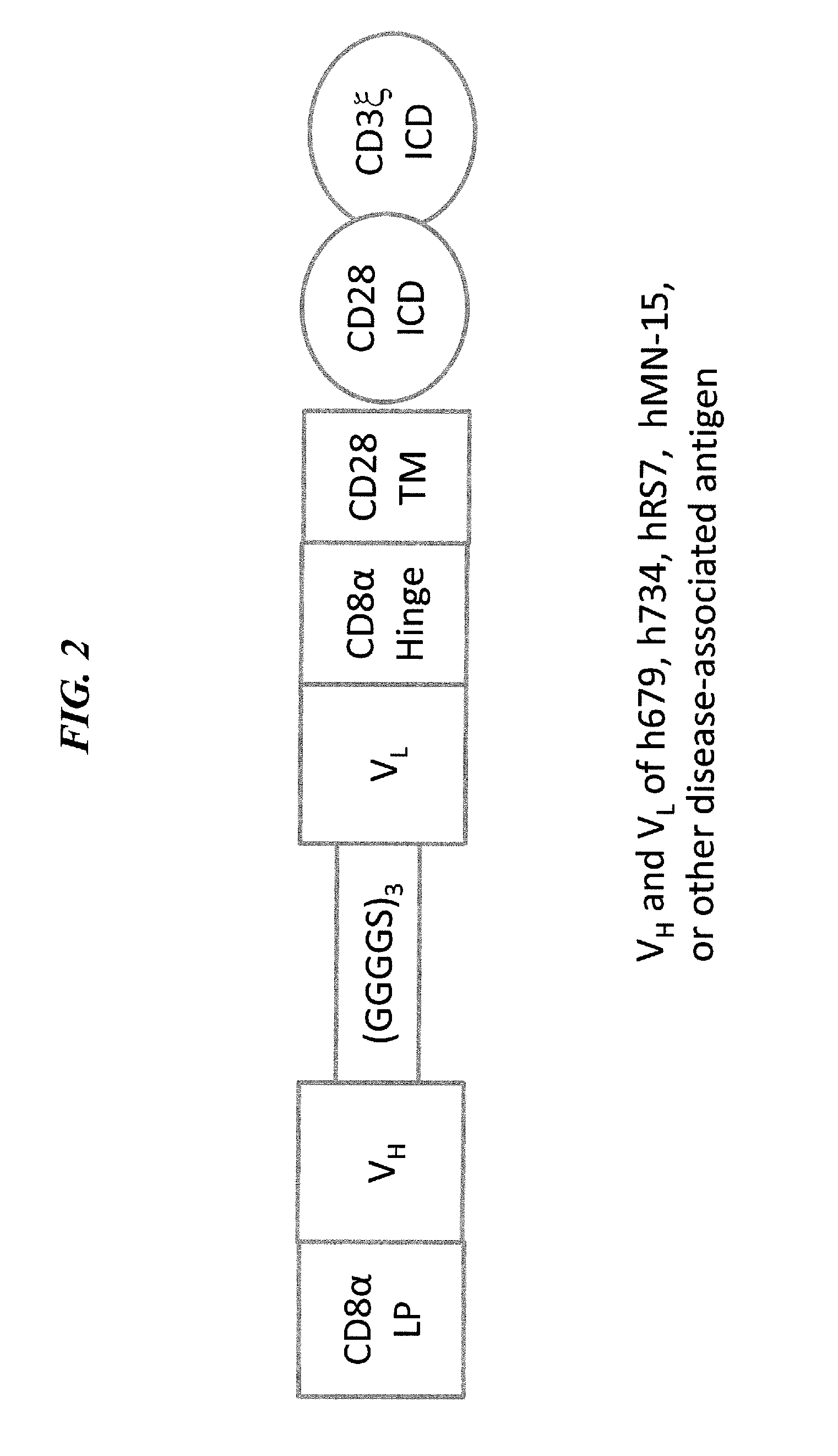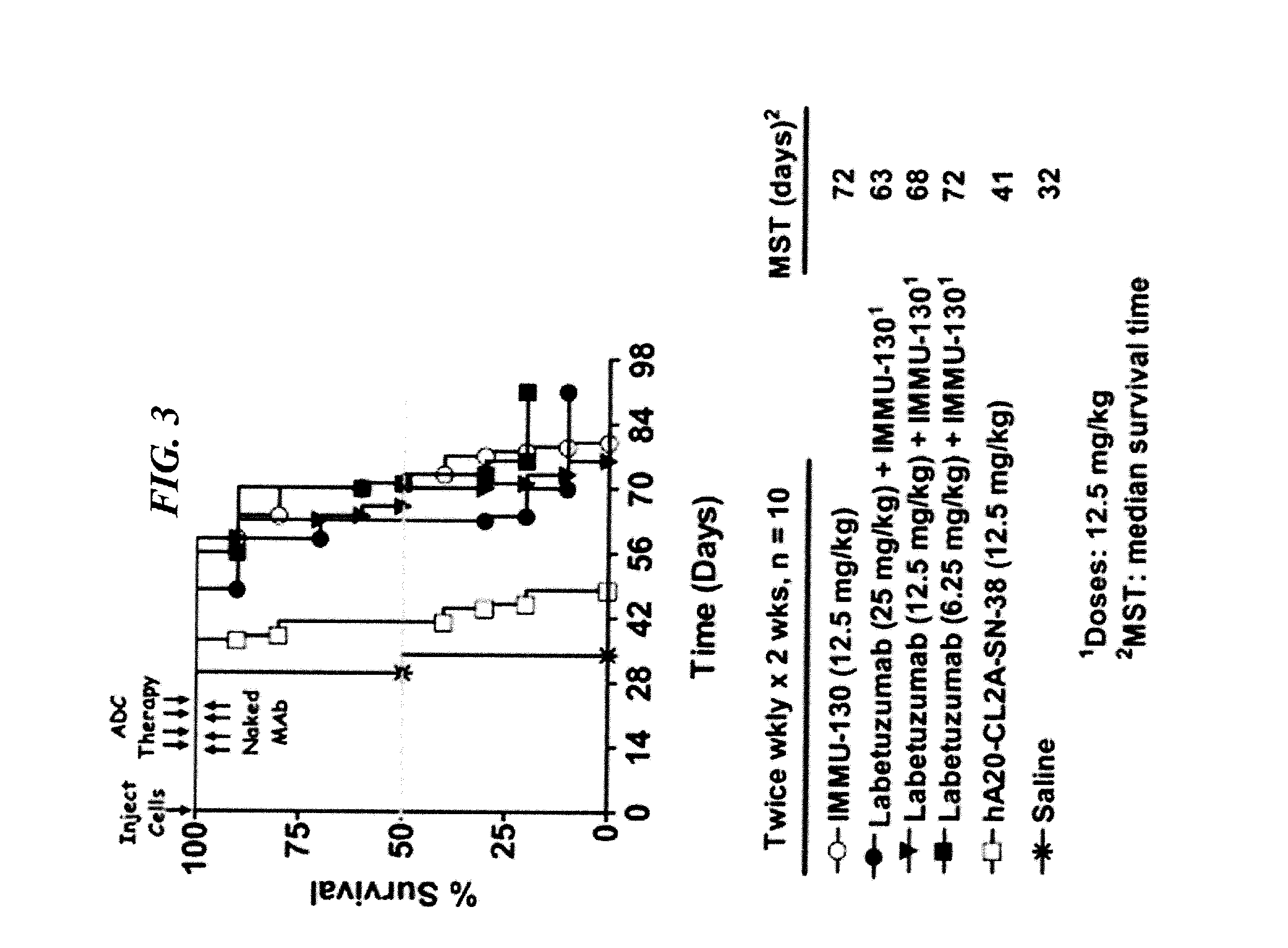Disease therapy with chimeric antigen receptor (CAR) constructs and t cells (car-t) or nk cells (car-nk) expressing car constructs
a technology of chimeric antigen receptor and construct, which is applied in the direction of antibody mimetics/scaffolds, peptide/protein ingredients, fusion polypeptides, etc., can solve the problems of systemic toxicities, severe weight loss, and death of subject mice, so as to reduce the effectiveness of host immune response, maintain self-tolerance, and modulate the duration and extent of immune response
- Summary
- Abstract
- Description
- Claims
- Application Information
AI Technical Summary
Benefits of technology
Problems solved by technology
Method used
Image
Examples
example 1
Amino Acid Sequences for Chimeric Antigen Receptor Production
[0204]The design, composition, and use of several families of novel T or NK cells, each engineered with a chimeric antigen receptor (CAR) capable of binding to histamine-succinyl-glycine (HSG), DTPA-labeled indium (DTPA-In), or Trop-2, are described below. One preferred embodiment of such CAR-T or CAR-NK cells relates to third generation CARs (Sadelain et al., 2013, Cancer Discov 3:388-98) comprising, for example, an extracellularly located single-chain Fv (scFv) linked to intracellularly located signaling domains of CD28, 4-1BB (CD137) and CD3ζ via a spacer derived from the CD8α hinge and a transmembrane domain derived from CD28. Another preferred embodiment concerns second generation CARs (Sadelain et al., 2013) comprising, for example, an extracellularly located scFv linked to intracellularly located signaling domains of CD28 and CD3ζ via a spacer derived from the CD8α hinge and a transmembrane domain derived from CD28....
example 2
Construction of Lentiviral Vectors for Expressing a Third-Generation CAR
[0206]HSG-Binding CAR
[0207]A schematic diagram showing an exemplary third-generation CAR construct is provided in FIG. 1. The CAR construct is produced as follows. The nucleotide sequence for the cDNA encoding a fusion protein CAR, comprising the amino acid sequences of h679-scFv, CD8α hinge, CD28 TM, CD28 ICD, 4-1BB ICD, and CD3ζ ICD linked in tandem (h679-28-BB-z, FIG. 1) is synthesized by standard techniques, PCR-amplified, and ligated into pCLPS, a third generation self-inactivating lentiviral vector based on pRRL-SIN-CMV-eGFP-WPRE (Dull et al, 1998, J Virol 72: 8463-71), or pELNS (Carpenito et al, 2009, Proc Natl Acad Sci USA 106:3360-5), which differs from pCLPS by replacing CMV with EF-1α as the promoter for transgene expression. The encoded CAR comprises an h679 scFv for binding to HSG.
[0208]In-DTPA-Binding CAR
[0209]The lentiviral vector for expressing the CAR comprising h734-scFv, CD8α hinge, CD28 TM, C...
example 3
Construction of Lentiviral Vectors for Expressing Second-Generation CAR
[0216]HSG-Binding CAR
[0217]A schematic diagram showing an exemplary second-generation CAR construct is provided in FIG. 2. The CAR construct is produced as follows. The nucleotide sequence for the cDNA encoding the CAR comprising h679-scFv, CD8α hinge, CD28 TM, CD28 ICD, and CD3ζ ICD linked in tandem (h679-28-z, FIG. 2) is synthesized by standard techniques, PCR-amplified, and ligated into pELNS, a self-inactivating lentiviral vector based on pRRL-SIN-CMV-eGFP-WPRE (Dull et al, 1998, J Virol 72: 8463-71), in which transgene expression is driven by the EF-1α promoter.
[0218]In-DTPA-Binding CAR
[0219]The lentiviral vector for expressing the CAR comprising h734-scFv, CD8α hinge, CD28 TM, CD28 ICD, and CD3ζ ICD linked in tandem (h734-28-z, FIG. 2) is constructed as described above, except that the nucleotide sequence encoding h679-scFv is replaced by that of h734-scFv.
[0220]Anti-Trop-2 CAR
[0221]The lentiviral vector fo...
PUM
| Property | Measurement | Unit |
|---|---|---|
| Time | aaaaa | aaaaa |
| Time | aaaaa | aaaaa |
| Time | aaaaa | aaaaa |
Abstract
Description
Claims
Application Information
 Login to View More
Login to View More - R&D
- Intellectual Property
- Life Sciences
- Materials
- Tech Scout
- Unparalleled Data Quality
- Higher Quality Content
- 60% Fewer Hallucinations
Browse by: Latest US Patents, China's latest patents, Technical Efficacy Thesaurus, Application Domain, Technology Topic, Popular Technical Reports.
© 2025 PatSnap. All rights reserved.Legal|Privacy policy|Modern Slavery Act Transparency Statement|Sitemap|About US| Contact US: help@patsnap.com



